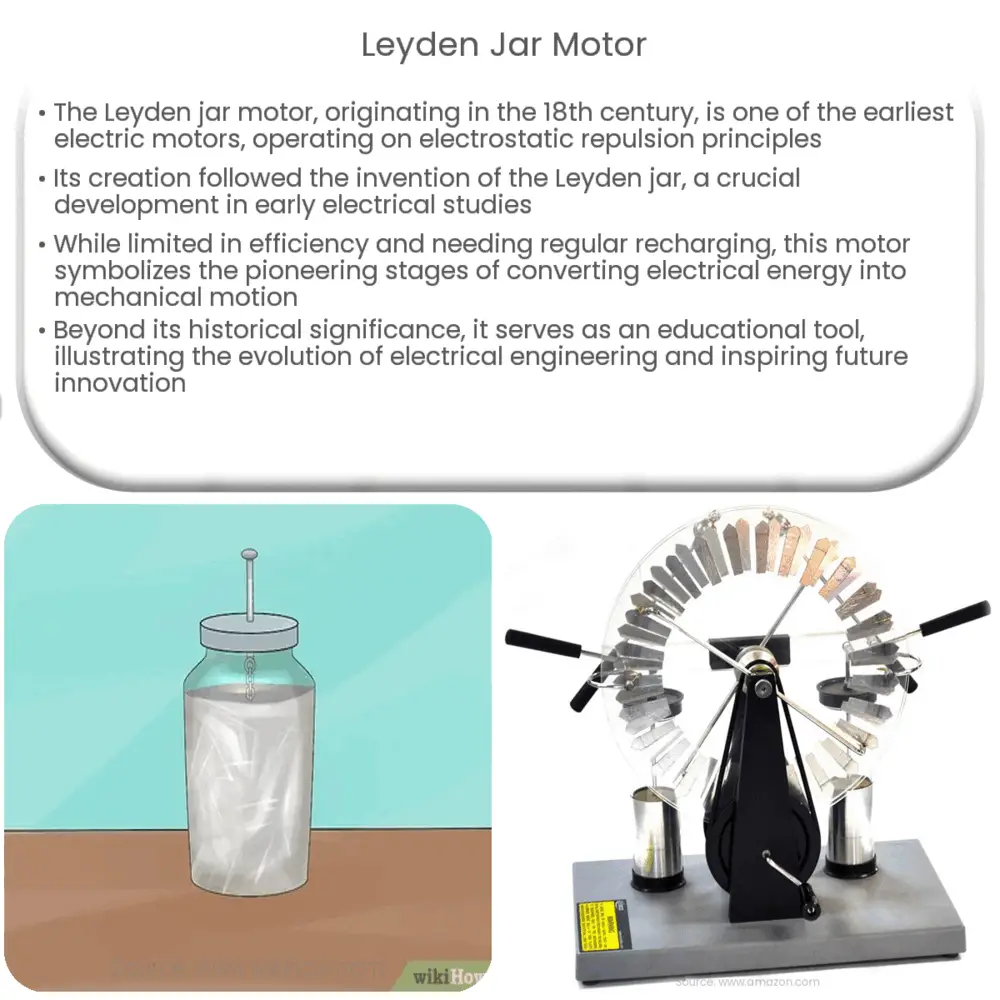The Leyden jar motor is an early electric motor that utilizes electrostatic repulsion, marking the beginning of electrical engineering advancements.

Leyden Jar Motor: An Exploration of a Historic Electric Motor
Introduction
The Leyden jar motor, an early electric motor, has a rich history and interesting applications that deserve attention. As a precursor to modern electric motors, the Leyden jar motor demonstrates the ingenuity of early scientists and engineers. This article will explore the origin, functioning, and significance of the Leyden jar motor.
Origin of the Leyden Jar Motor
The Leyden jar motor traces its roots back to the invention of the Leyden jar in the 18th century. The Leyden jar is a simple capacitor, invented independently by two scientists: Ewald Georg von Kleist, a German cleric, and Pieter van Musschenbroek, a Dutch scientist. This device was named after the Dutch city of Leiden, where Musschenbroek worked. The Leyden jar was an important development in the field of electricity and was used extensively in early electrostatic experiments.
Subsequently, Andrew Gordon, a Scottish monk, developed the first Leyden jar motor in 1745. He utilized the energy stored in a charged Leyden jar to drive a simple motor. This marked the beginning of a new era in electrical engineering, as scientists began to explore practical applications for electricity.
Functioning of the Leyden Jar Motor
The Leyden jar motor operates on the principle of electrostatic repulsion. A charged Leyden jar is connected to an axle that has two lightweight metal arms. These arms are mounted with metal spheres at their ends. As the Leyden jar discharges, the electric potential in the arms causes the metal spheres to repel each other. This repulsion results in the rotation of the arms, which drives the motor.
As the Leyden jar discharges, the potential difference between the armature and the jar decreases, reducing the electrostatic force. Eventually, the jar needs to be recharged for the motor to continue operating. Although this motor is rudimentary compared to modern electric motors, it demonstrates the basic principle of converting electrical energy into mechanical energy.
Significance of the Leyden Jar Motor
The Leyden jar motor holds historical significance as one of the earliest examples of an electric motor. This invention laid the foundation for further developments in the field of electrical engineering. While the Leyden jar motor had limited practical applications due to its low efficiency and the need for constant recharging, it showcased the potential of harnessing electricity for practical uses.
The Leyden jar motor also played a role in the development of electrostatic generators. Benjamin Franklin, for example, used a Leyden jar to conduct his famous kite experiment, proving the electrical nature of lightning. This motor, therefore, represents a stepping stone towards modern electrical devices and systems.
Evolution of Electric Motors
Over the years, the principles demonstrated by the Leyden jar motor have been refined and advanced, leading to the development of more efficient and powerful electric motors. In the early 19th century, scientists such as Michael Faraday and Joseph Henry made groundbreaking discoveries in electromagnetism, paving the way for the invention of the first electromagnetic motor. These motors harnessed the power of magnetic fields to generate mechanical force, making them more efficient than their electrostatic counterparts.
With the advent of the industrial revolution, electric motors gained widespread use in various industries, from transportation to manufacturing. The efficiency, versatility, and scalability of modern electric motors owe much to the pioneering work of early scientists who experimented with Leyden jar motors and other electrostatic devices.
Leyden Jar Motor in Education
Today, the Leyden jar motor serves as an educational tool in the study of electricity and electromagnetism. By building and experimenting with simple Leyden jar motors, students can gain a deeper understanding of electrostatic principles and the conversion of electrical energy into mechanical energy. This hands-on experience can spark interest and curiosity in the fields of science, technology, engineering, and mathematics (STEM).
Moreover, the historical significance of the Leyden jar motor teaches students about the development of technology over time and the importance of experimentation and innovation. Understanding the humble beginnings of electric motors can inspire future generations of scientists and engineers to continue pushing the boundaries of what is possible with technology.
Conclusion
The Leyden jar motor, a simple yet remarkable invention, has left an indelible mark on the field of electrical engineering. As one of the earliest electric motors, it demonstrates the ingenuity of early scientists and engineers who sought to harness the power of electricity for practical uses. While the motor itself had limited applications, it played a crucial role in the development of more advanced electric motors and contributed to our understanding of electrostatic principles.
As a historic and educational tool, the Leyden jar motor continues to inspire curiosity and appreciation for the evolution of technology. By learning about this early motor, we gain valuable insights into the importance of experimentation, innovation, and the relentless pursuit of knowledge that has shaped the world we live in today.




